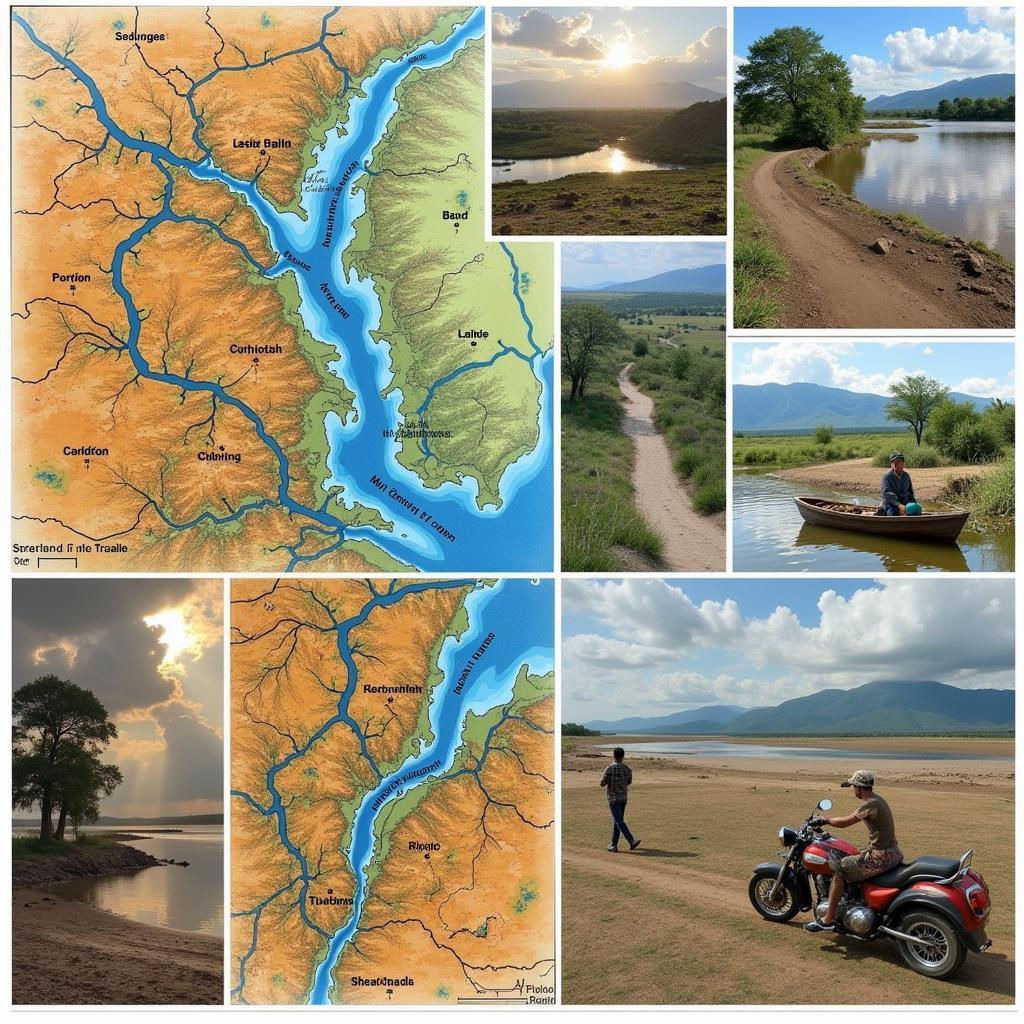Exploring African Drainage Basins: Rivers, Lakes, and Landscapes
African Drainage Basins are a complex and fascinating network of rivers, lakes, and wetlands that shape the continent’s diverse landscapes and support its rich biodiversity. These basins, essentially areas where surface water converges and flows towards a common outlet, play a critical role in the lives of millions of Africans, providing water for agriculture, industry, and domestic use.
Understanding the Importance of African Drainage Basins
Africa’s drainage basins are not just geographical features; they are lifelines. They are vital for agriculture, providing irrigation for crops and supporting livestock. They are also essential for generating hydroelectric power, a crucial source of energy for many African countries. Moreover, these basins support unique ecosystems, teeming with diverse flora and fauna, contributing significantly to the continent’s biodiversity. The intricate interplay between the basins and the environment makes them a crucial area of study for understanding Africa’s ecological balance.
Key Drainage Basins of the Continent
Several major drainage basins dominate the African continent, each with its unique characteristics and influence on the surrounding environment. The Nile Basin, home to the world’s longest river, stretches through eleven countries and plays a crucial role in the history and development of ancient civilizations. The Congo Basin, the second largest in the world, boasts incredible biodiversity and is vital for regulating the regional climate. The Niger River Basin, another major system, supports agriculture and livelihoods across West Africa. Finally, the Zambezi and Orange River basins in southern Africa are significant for their hydroelectric potential and diverse ecosystems. Understanding the characteristics of each basin is essential for appreciating the diversity and complexity of African geography.
The African Great Lakes region, located within several drainage basins, adds another layer of complexity and ecological significance. This region, holding some of the world’s largest freshwater lakes, is a hotspot for biodiversity and faces unique environmental challenges. Learning more about the Great Lakes region provides deeper insights into the intricate relationship between water resources and the African environment. african great lakes region map
What Factors Influence the Formation of Drainage Basins?
Several geological and climatic factors shape the formation and evolution of African drainage basins. Tectonic activity, the movement of the Earth’s crust, plays a crucial role in creating valleys and mountains, influencing the direction of river flow. Climate patterns, including rainfall and evaporation rates, determine the volume of water flowing through these basins. The interplay of these factors over millions of years has resulted in the diverse drainage patterns we see today. Understanding these processes provides valuable insights into the dynamic forces shaping the African landscape.
How Climate Change Affects African Drainage Basins
Climate change poses significant challenges to the delicate balance of African drainage basins. Increased droughts and floods are impacting water availability, affecting agriculture and livelihoods. Changes in rainfall patterns are disrupting the flow of rivers, affecting hydroelectric power generation and increasing the risk of water scarcity. Addressing these challenges requires sustainable water management practices and adapting to the changing climate.
“Climate change is not just an environmental issue; it’s a human issue,” says Dr. Abeni Adebayo, a prominent hydrologist specializing in African water resources. “Its impacts on drainage basins have far-reaching consequences for communities that rely on these vital resources for survival.”
 Impact of Climate Change on African River Basins
Impact of Climate Change on African River Basins
The Importance of Sustainable Water Management
Sustainable water management is crucial for preserving the health and productivity of African drainage basins. Implementing effective water conservation strategies, promoting responsible agricultural practices, and protecting the natural vegetation cover are essential steps. International cooperation and sharing best practices are critical for addressing transboundary water management challenges. By working together, African nations can ensure the long-term sustainability of their precious water resources.
“Sustainable water management is not just about conserving water; it’s about ensuring equitable access to this vital resource for all,” says Professor Kofi Asante, a leading expert in African environmental management. “It requires a holistic approach that considers the interconnectedness of water, ecosystems, and human livelihoods.”
Exploring the Biodiversity of African Drainage Basins
African drainage basins are home to a remarkable array of plant and animal life. From the iconic Nile crocodile to the diverse fish species of Lake Tanganyika, these ecosystems support a wealth of biodiversity. Protecting these habitats is crucial for maintaining the ecological balance and preserving the continent’s natural heritage.
Conclusion
African drainage basins are vital natural resources that play a critical role in shaping the continent’s landscapes and supporting its people and wildlife. Understanding their dynamics and the challenges they face, particularly in the context of climate change, is essential for ensuring their sustainable management and the long-term well-being of Africa. African drainage basins are a testament to the continent’s rich natural heritage and its potential for sustainable development.
When needing support, please contact Phone Number: +255768904061, Email: kaka.mag@gmail.com Or visit Mbarali DC Mawindi, Kangaga, Tanzania. We have a 24/7 customer support team.


